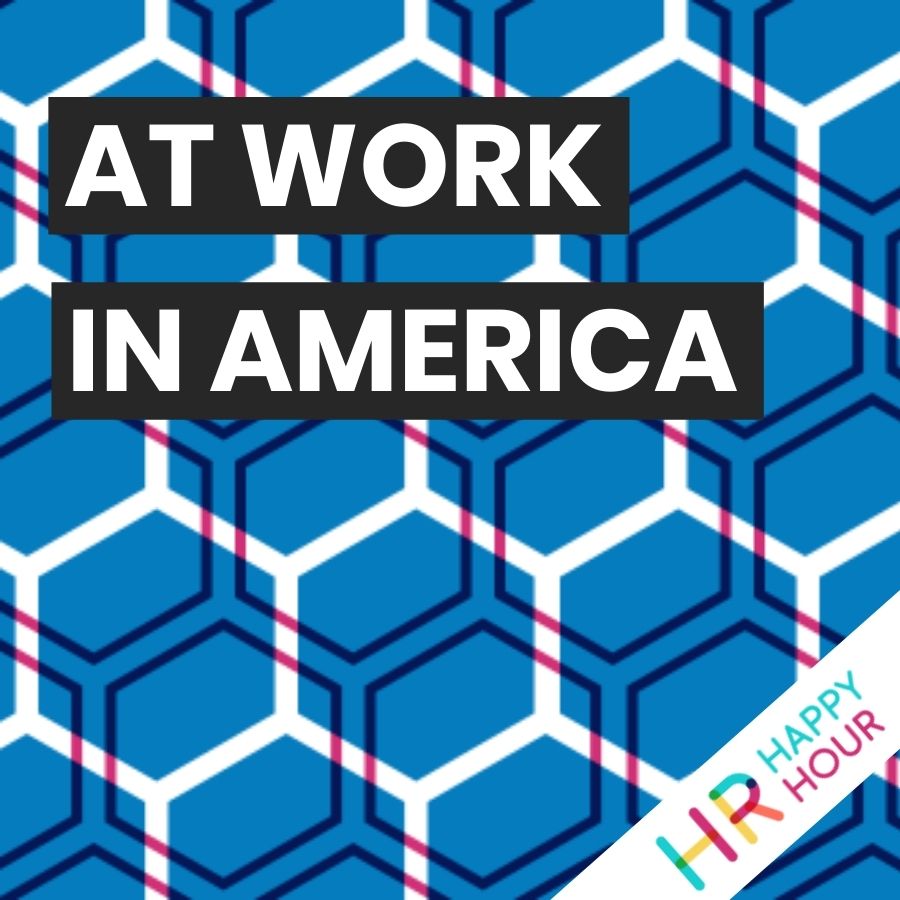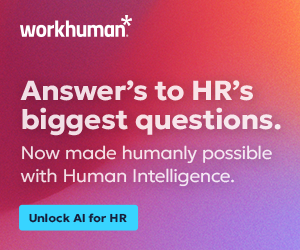How to Close the Growing Skilled Trade Shortage in the U.S.
Hosted by

Steve Boese
Co-Founder and Chief Data Officer of H3 HR Advisors and Program Chair, HR Technology Conference

Trish Steed
Co- Founder and Chief Strategy Officer, H3 HR Advisors
About this episode
542 – How to Close the Growing Skilled Trade Shortage in the U.S.
Hosts: Steve Boese, Trish Steed
Guest: Adam Figueira, VP of Marketing at CourseKey
This episode of At Work in America is sponsored by Paychex, one of the leading providers of HR, payroll, retirement, and insurance solutions for businesses of all sizes. The current business and hiring environment has redefined what it takes to succeed as an HR professional, requiring HR leaders to adapt and innovate at lightning speed to help their organizations remain competitive. Download the 2022 Paychex Pulse of HR report to discover the tools and tactics your peers are using to deliver on both HR and business objectives – faster and at scale – while still meeting the evolving needs of their employees. Visit payx.me/PHR2022 to download your copy, today.
This week, we met with Adam Figueira from CourseKey to learn more about how to help close the skilled trade shortage in the U.S.
– Meeting the needs of career colleges and trade schools
– How trade schools provide a faster path to entrepreneurship
– Importance of trade school representation at the high school level
– Hiring skilled workers
For more information, click here
Thank you, Adam, for joining the show today! Remember to subscribe to At Work in America wherever you get your podcasts.
Transcript follows:
Announcer 0:27
Welcome to At Work In America sponsored by Paychex. We welcome a wide and exceptionally impressive array of guests, business leaders, HR leaders, academics, practitioners, consultants and authors to talk about the most timely, relevant and challenging issues that are influencing the workplace today. At Work in America digs in behind the headlines and trends to the stories of real people making a difference in the world of work. And now here are your hosts, Steve Boese and Trish Steed.
Steve 1:01
Welcome to the show, we have a great show today Trish, we’re going to be talking about a topic I love. And we have not talked about in quite some time. We’re going to talk about skilled trades, vocations, and kind of talk a little bit and push up against this idea that every single person needs to go to like a four year college and come out with like, a degree in history. I like history, by the way, no knocking the history majors, but we’re going to talk about skilled trades, the shortages and some of the ways organizations can kind of improve right and help find the folks that they need, and learn a little bit more about how those folks get ready to take those kinds of jobs.
Steve 1:36
We’re going to be joined by Adam Figueira from CourseKey here in a moment. Before I formally welcome Adam to the show. Trish, can I thank our sponsors? Is that all right?
Trish 1:45
Please do.
Steve 1:47
Let us thank our friends at Paychex. This episode of At Work in America is sponsored by Paychex, one of the leading providers of HR Payroll, retirement and insurance solutions for businesses of all sizes. The current business and hiring environment has redefined what it takes to succeed as an HR professional, requiring HR leaders to adapt and innovate at lightning speed. To help their organizations remain competitive, you can download the 2022 pulse of HR report to discover the tools and tactics your peers are using to deliver on both HR and business objectives. Trish coming up, I’m gonna deviate off script, I downloaded the Pulse of HR Report again earlier this week because I cited it in an article I was writing for HR Executive. So how about that?
Trish 2:28
I think that’s good. And I’m glad they’re sharing that because I can tell you when I was an HR leader, that was one of the things I looked for, I was always trying to find ways to train my team for free. So it’s also a good resource for that, take that report. Get your team together, maybe for a lunch and learn. Dive into it, ask questions about it. It’s a really great training tool for your tickets.
Steve 2:50
You should provide lunch though, if you’re doing that. You can visit a payx.me/phr2022 like me to download your copy today. And many thanks to our friends at Paychex. Okay, let’s welcome Adam to show he’s waiting patiently. Adam, as I said, he’s the VP of Marketing at CourseKey. We’re gonna learn about that because I think there’s a good chance he might not be familiar to many of our listeners. So we’re gonna learn about that. But Adam, before CourseKey, ran b2b Marketing at Trilogy eEducation Services, a workforce accelerator that partners with leading universities to power skills based training programs. He joined that company pre series A and helped manage the Trilogy brand, from sub 10 million in revenue. That’s does sound like a lot to me already. 200 million plus and a 707 or $50 million exit nice in 2019 trilogy was the fastest growing edtech company in history. And the second largest acquisition of an Ed Tech company. Welcome to the show, Adam, that is pretty impressive. I might have put a 10 million I’m not as ambitious. That sounded good. But that’s awesome. So how are you?
Adam Figueira 3:59
Well, thank you. I appreciate that. I’m doing well, Steve, thank you Trish as well. I’m happy to be on here talking about this topic with you today. Because as you said at the beginning, Steve, this is a very important topic that more people should be talking about, because it’s instrumental to the economy. So I appreciate you giving me the opportunity to come on and share a little bit about it.
Steve 4:20
Yeah, it’s our pleasure, Adam, thank you. Maybe we’ll start with give us 90 seconds, two minutes on just on CourseKey. So we can be familiar with the company what you guys do, again, for folks who may not know the brand name and know the products and services all that well.
Adam Figueira 4:36
So CourseKey is a software company. We’re an Ed Tech company, and we specifically serve the needs of career colleges and trade schools. And let me put that into context for you because I’ve been in edtech for a long time, right? Most of the money that flows into edtech companies goes to one of two places it goes to companies trying to serve K 12 and companies trying to serve Have a four year higher ed. There are very few providers that actually cater to the needs of career colleges and trade schools. And those needs are incredibly unique because of the regulatory environment that those types of schools operate and the nature of the programs, right, they’re very hands on, they’re less sort of academic and in the classroom. And so we’ve developed a specific software suite that just responds and responds to and reflects the needs that those schools have. And it covers everything from enrollment, academic management, retention placement, it really is mapped around the entire student journey.
Steve 5:45
Great, appreciate that. And we’re talking about, just so I’m clear on this. Schools that train mechanics, train people in who might become beautician’s, welders, I mean, lots of things, right?
Adam Figueira 6:00
Yeah, that’s exactly right. I mean, one of the definitions of a trade, I think there’s probably a lot is any job that has the potential to be hazardous, either to the public, or to the practitioner, right. And so when you think about it like that, it makes sense why we talk about, you know, auto mechanics as a trade, right, the job needs to be done, right, or it’s a danger to the driver to danger other people on the road. Same thing for, you know, hard trades, whether we’re talking about, you know, welding and plumbing and so forth. You know, even even beauty and wellness, as you said, right, when we talk about things like, you know, bleaching hair, you know, for example, or dyeing hair, there needs to be a real set of skills and training behind it so that the public can have confidence that it’s been done correctly.
Trish 6:54
I’m so glad you’re here to talk about this, Adam, because I live in the Midwest, I’m outside of St. Louis. And I wonder if this is more regional in the US, or if this doesn’t really matter where you live, but I feel like here we do have I have twins that actually just went off to college this week, in fact, to the University of Nebraska, but we live in a small town outside of St. Louis. And a lot of the students actually are going into the trades. So I guess, you know, as you’re talking about potentially being in these hazardous roles, things where you actually do need highly, technically trained skills, what is the overall kind of appetite, if you will, for trade schools in general? And how does CourseKey really kind of helped direct people to those types of careers?
Adam Figueira 7:42
So the great thing about that is that the appetite, I think, is changing, right? In a very positive way. I think to a large degree, we still live in a country where going to a trade school is seen as a consolation prize, compare compared to the four year university degree. But the reality is, is, you know, all of the economics show and by the way, I’m not you know, I don’t I don’t criticize four year higher ed, I, myself am a product of four year higher ed. But the economics of it are that it takes four years to complete, it can cost as much as 250 to $300,000. If we’re talking about, you know, a price,
Steve 8:28
By the way, for folks listening to the audio, yeah, everyone’s nodding, yep.
Trish 8:31
Yeah, his is at Boston University, we’re spending too much money.
Adam Figueira 8:36
Exactly. So you know, right. So in terms of the duration of these programs, the cost of these programs. For years more and more people, and this includes the students, as well as their parents have been questioning the ROI of that, when you compare that to trade schools, however, you’re talking about programs that are one to two years in duration, with an average price tag of 20 to $30,000. And the key thing about the trades is that they are aligned to a need in the market. Right. So you’re essentially starting with a job and reverse engineering that into curriculum. Whereas, you know, and I can say this because I was an international relations major, right. What do you do with that? Right? The short answer is almost nothing. Right?
Steve 9:30
As you were describing it, I had written down a more clearly defined career path right upon graduation or achieving that certification. And I suspect, Adam, when you graduated, you really didn’t think about going into your downtown and opening up a international relations shop. Right? That probably was not a thing you could have done, right.
Adam Figueira 9:53
Yeah, exactly. And on that particular topic, actually, we see in the trades that there is a a much clearer and faster path to entrepreneurship. Right. So knowing a trade having a skill is a very clear path to building your own business being your own boss making your own hours employing a workforce of your own right, as a marketer, right? I mean, I’m not going to create a marketing agency, right? That’s just not my thing. But for people who are, you know, have skills in cosmetology? Or who are welders or general contractors? Or if we’re talking about truck drivers, owner operators, right? These are entrepreneurs, these are people who run small businesses, it is a very clear path to entrepreneurship in the US.
Trish 10:46
Yeah, I think you’re right about the need for it. Like I said, it’s, at least where I live, it is not seen as some sort of lesser valued alternative. In fact, quite a large number of the students are actually excited about getting into the trades for that very reason, because they want it to be their own boss. Ultimately, they want to have a very specialized skill set that they can get in a shorter amount of time and start making money. Like right away some of the kids that literally just graduated here are already doing apprenticeships as they’re going to a vocational school and, and starting to, to live that career. Day one. So I think it’s a little different. And it’s not seen as a negative at all, at least, not here in the Midwest, it’s seen as a positive.
Adam Figueira 11:28
That’s great. And nationally, it seems like we hit an inflection point around 2010. So if you look at if you look at enrollment trends at four year universities, it essentially peaked in 2010. And since that time has dropped 2% a year, it as much as six to 8%, in 2020, when the pandemic you know, shut on campus instruction down. But still, it is a downward trend. It is the exact opposite with career colleges and trades, because of you know, because of all the things that we’ve talked about so far, and also, these tend to be geared towards industries, which are much more recession proof, right? So the economy may be down a little bit like it is now. But people still need to get a haircut, or even if they don’t need to get their nails done. They want to, right. And there’s all sorts of similar corollaries for the other industries as well.
Steve 12:31
And one of the really interesting things about the trades and these types of jobs and sort of folks who have prepared themselves and go to these types of schools, or go through these programs prepare for their careers, oddly enough, right. And we, I would say, certainly before the pandemic, and maybe a couple of years before that, I felt like we spent a lot of time navel gazing about robots coming to take everyone’s jobs away. I know I missed a row 1000 blog posts about that topic in different formats. But oddly enough, a lot of what we’re talking about Adam, and I think I hopefully you’ll agree with me, are are those exact jobs that cannot be automated away or certainly not easily? Right. Bus drivers, mechanics, beauticians people doing those hands on jobs that require both skill, some training, some dexterity, human ingenuity and thinking and a little bit of creativity at times, certainly not the kinds of jobs we just are going to throw technology at and they’ll be gone.
Adam Figueira 13:29
You know, when I was in business school, I had a professor who said, You can’t outsource a haircut. Right. And we were specifically talking about outsourcing. But that quote, what he said has stayed with me for for a very long time. And I think, you know, to your point, when it comes to automation, you know, you can automate aspects, certain aspects of jobs, you can make them, you know, more efficient, you can make you can make the performer of the job more efficient. But for the most part with the trades, they are highly resistant to automation, for all of the work and investment that has been put into, you know, autonomous driving, the reality is, is we still are not there. And you know, even even in the military, when we talk about autonomous, you know, aircraft, in most cases, I think they’re still piloted by somebody on the ground. So we’ve just shifted where the pilot is, but we haven’t eliminated the pilot from the equation. Right. So automation tends to change the nature of work. But I think it may be a little bit overstated, as far as, you know, putting people putting people out of work. It just changes how the job is done.
Steve 14:45
Yeah, I mean, a number of years ago, a really famous study made the rounds came out of Oxford University and basically concluded that the number one job that was almost certainly going to be automated away in the reasonably near future was accounting, right? Because it was really just following rules and moving numbers around in certain fashion. I was a frustrated accountant myself, but I get where that’s coming from. It’s like, Yeah, we could probably make rules and have a machine do a lot of this.
Adam Figueira 15:17
Yeah, that’s exactly right. I recall a study from a couple years ago, it was three or four years ago came from McKinsey. And it said that 65% of kindergarteners today would go on to work in jobs that don’t yet exist today. And it was making a bigger point about, you know, automation, changing the the nature of work. But again, I think, you know, a power a cordless ratchet hasn’t made, the general hasn’t put the general contractor out of work. It’s made the general contractor more efficient with his or her time.
Trish 15:51
Yeah, for sure. No, it’s interesting. You mentioned that because I was just having a discussion with my kids, and my niece and nephew, going away to a four year university where I told them, I said, even now, not as kindergarteners, but at their age 18 and 20, the job that you are going to have probably does not exist in the way that you’re thinking about it. And so that’s if you’re someone who likes that sort of unknown, and you can live with that, that’s fine. But I think too, there are lots and lots of young people who want to know, what am I going to do? What is that basic skill going to require? And so again, if I had a student who was more of that mode of thinking, I might actually then steer them toward a trade because I think to some people just operate better knowing I’m going to go to school for this thing, this craft the skill, and then I’m going to get a job doing that. And like your point, it can be enhanced, certainly by technology. But I went to school and got a degree in sociology, like, I don’t know what I was going to do with that I’ve had probably 20 ideas that none of which I’ve done. But you know, so I think that’s another big difference between a four year university and a trade is that if you’re someone who really wants to have that solid foundation of this is what I want to do and be as it evolves, I might steer my child toward a trade school. Are you finding that other parents or teachers, counselors, maybe school counselors are, are sort of using, you know, technology to connect them to the schools to steer kids maybe with that sort of mindset to them? Or is that not something that they’re really doing just yet?
Adam Figueira 17:33
Well, I hope it is, right. I mean, I’m a number of decades removed from high school at this point, but when I was in, it was only four year colleges that came around, right. And I was actually speaking to somebody a few weeks ago, from Kansas City, so the other side of Missouri, and he had graduated high school in 2008. And what he what he said to me was, none of the trade schools had come to his school. He’s a professional welder today, but he was on camera telling us, nobody ever came to the school and told us about, you know, welding. Right. And I think that is changing in the US. And I think that parents are much more receptive to it, you know, as well, again, because the economics, you know, just totally back it up as a as a great as a great career option, a path that has high earning potential stability, right. And ultimately, whether you’re, whether you are the student, the employee, or the parent, I think that’s what you want, right?
Trish 18:43
It’s hard enough to get a job right now. And if you think about it, if you need to get your car worked on right now, or someone to come, you know, do something to your home, for example, repair something, an electrician, plumber, whatever, it is almost impossible, like they’re so backed up. So there’s such a need there for any of those trades to get these students to come in and learn them. They really need them right now.
Adam Figueira 19:07
If I posted a job opening on our website today, for a marketing role, we would have 100 applications within 48 hours. If I call around to try to get quotes on remodeling my house, I think 50% of the people I called would probably not call me back and the 50% who did would not be available for 6, 8, 12 weeks or more to do the job. And I think it sort of speaks to the idea that there are you know, there’s more than one economy in the US, right, there is the professional economy, which may have I mean, in the professional economy, there’s a clear mismatch of skills, I think, right there are there are more workers in areas where you know that their skills are not aligned to the needs of the market and in the trade economy. The complete opposite, which is there’s simply not enough workers. And we’ve got to correct that, right. I mean, when, when the stimulus package during the first Obama administration was passed, which I think was 2008 or 2009, Obama said something that was very famous, I don’t think it ever got the attention it deserved. But he said, There’s no such thing as a shovel ready project. And what he what he actually meant by that was the, there’s not enough workers to do the jobs that there may be money for. But if workers are not there and ready to do it, it’s not quote unquote, shovel ready. And by the way, we’re seeing this again, 14 years later, because we have a $1.2 trillion infrastructure bill that was passed last year, that money has now started flowing. And people are starting to talk about what we’ve been talking about for a long time, which is, actually you know, what, the money wasn’t the problem at all. It was the lack of skilled labor to do the work.
Steve 21:11
Yeah. And you’re seeing the two economies. Idea, Adam really does resonate. And we’re seeing this I’m a bit of a labor market geek for folks who have listened to the show for for many years. They know this about me. And we’ve been seeing nothing in sort of the popular news or the businesses in the last couple of months or so layoffs here. layoffs, there are layoffs or, you know, peloton laid off another 100 people or something like that, right? And but yeah, in the last jobs report that came out about two weeks ago, as we record this, over half a million jobs were added to the economy, largely those second economy types of jobs. Right. So meanwhile, lots of people are talking about imminent recession and things like that, and maybe things are slowing down in certain pockets of the economy. But I think you’re right, Adam, it tends to be that professional economy, right, that’s seeing the effects of it, where, where maybe some companies, I don’t know, got ahead of their skis a little bit. And now we’re pulling back. But meanwhile, a lot of the things we’re talking about, and a lot of the things that the course key client community is preparing folks to step into right are still in tremendous demand and probably will remain that way.
Adam Figueira 22:21
I haven’t heard any layoffs of truck drivers and you know, welders and plumbers and things like that. And I just think it speaks to the acute need that we have.
Steve 22:32
We just did. This is a global story. But it could be here we just did a story about on one of our other shows about cuantas Airlines is pulling people out of the corporate offices in the executive suites to drive baggage trucks back and forth across the tarmac to try to match up people with bags. Trish, you can tell the story, if you want to, you’re caught up in some baggage chaos yourself, I think.
Trish 22:59
You know, I think we probably overdone that story. But I think that you’re right, I think anytime you have someone who’s so highly trained, so highly skilled, maybe from a four year university, and you get in your head, like I’m an executive, I’m a there’s some of that, right? You have to be able to step out of that occasionally and do the job that needs to be done. And so whether that’s yes, delivering bags, or whether that’s, you know, obviously you can’t just go step in and be a truck driver. But I think that’s it’s just important, even more than before now to be talking to these kids, or if you’re in these vocational colleges, you know, you made the point about your friend who was in Kansas City, and he wasn’t seeing that when he was, you know, graduating and making these decisions. I do think that maybe it is a little bit of where you you live here, here, they do come to the high schools. So again, how as a marketer, how do you see us being able to sort of elevate the respect for those roles? And not just the respect for them, but the knowledge of them? How do we get these types of workers in front of young people or representatives from these vocational schools to where they can start kind of spreading that word?
Adam Figueira 24:10
You know, kids need to see more examples of people who do these jobs, right. Kids follow heroes, right, whether that’s a sports star, or whether that’s an entertainer and I think they could benefit from and we as a country could benefit from exposing those kids to more career paths, right. And enabling them to, you know, meet these individuals see these jobs and develop an interest in it. There was a study and I don’t, I don’t recall where it came from, but it was the results of it was something to the effect of, by the time a kid an adolescent on authorized term is gets to age 13. They have made at least Have a general decision around the path that they’re going to pursue, right? It may not be, I know I’m going to be a mathematician versus a sociologist, but they’ve decided it’s going to be this path or that path. And so it speaks to the need of, you know, you’ve got to reach people with this message. And with these examples, you know, earlier, there is, there is an author, Molly Elfman, she wrote a children’s book last year called the house that she built with emphasis on children’s book. And it’s based on a true story about a house in Utah that was built by all female laborers. And the point of it, the the point in making it a children’s book is to provide an example in this case to younger girls, that this is a viable path for you right in in home construct in residential home construction. And I think probably commercial construction as well. Fewer than 5% of the workers are female, right? I’m sure there are many reasons for that. And I don’t want to reduce it to any, you know, one reason. But I do believe that one of the reasons is, we don’t have enough examples of female construction workers to show girls younger than the age of 13, that this is a path that they can do as well.
Trish 26:24
Yeah, that’s, it’s interesting, that is a children’s book, because that just reminded me, one of the books like, you know, we all have books growing up, one of the few books I actually still have from my childhood is called Susan in the driver’s seat. So I grew up in the early 70s. And it was a whole book, a good little golden book about women could be a woman could be a doctor, a woman could be a pilot, a woman could work in construction. So so funny that like, we’re now you know, 50 years later, and it just hasn’t changed that much. Like, you know, obviously, you know, CourseKey is doing its part to sort of help this what, what can we be doing, right, as consumers, as parents, as educators, as a community, what can we be doing to help steer young women to be thinking about these things? Especially if you’re saying, you know, kids are really thinking about this before age of 13? I mean, you know, what, can we do different?
Adam Figueira 27:19
Yeah, I mean, so I am a big believer, and I can’t remember, I feel old at this point. But I don’t feel like I was exposed to a career day until I was in high school. I think these things need to go into middle school and elementary school as well. Right. And then I think, you know, to use your example, Trish of, you know, we were just talking about female construction workers, when parents see to you, I’ll continue with the example of female construction worker, talk about that with your kids, hey, this can be something that you do as well, there’s great jobs here, there’s great earning potential here, you don’t have to be, you know, maybe what you see just on television, or what you hear, you know, from from your friends or somebody else, right. And it speaks to it, it speaks to this critical problem that we have, which is when it comes to the skills gap that we have in critical trades, you can’t solve it by only marketing, or reaching 50% of the population. Right? So if the only people who are exposed to this are the only people who to whom these programs are marketed to our men, we’re not actually going to solve this. Like it’s not even that it’s an uphill battle. No, that’s actually being too generous, we are not going to solve it, when we’re only reaching half of the population.
Steve 28:49
Yeah, I gotta believe it. I’m sorry.
Trish 28:52
I was just gonna quickly say, I think if you’re a parent, it is your job to find those opportunities for your children, right? Even if you don’t know the person, if you you know, take them to some some of these jobs. Or if you have someone come work on your home, ask them hey, would you mind just spending five minutes with my kid and like telling them about what you do? Right? Make sure you’re making those connections. And I would also just say, look to your local community, whatever that is, and find those people who are in those jobs and see if you can job shadow them. I know, you know, Steve and I and what we do, we did a little bit of a job shadowing for some kids at the local high school who were into podcasting and wanted to learn more about it. So we did that. We’ve had a guest on the show, who is the Executive Director for I was looking at for the National Corn to Ethanol Research Center. Right? So very agricultural, like you wouldn’t just like grow up thinking like wow, I want to do that. But our friend John Caupert. Actually, I know he does job shadowing for anyone that just might want to learn more about corn and ethanol and how that all works. So I think you can Even if you don’t know someone personally, if you make a phone call, and try and get your kid in front of people who can teach them a different type of profession than what you do is a good first step.
Adam Figueira 30:09
That’s exactly right.
Steve 30:11
Here’s my last quarter of observation and maybe question for you too. And it’s tricky. So, I mentioned prior to we started recording kind of the last time we talked about this topic, these that length on the podcast was a while ago now. And we talked to a couple of authors from MIT, who had written a pretty deeply researched book on workforce development kind of writ large in the United States, but with an eye towards how are organizations right going to find the trained and skilled workforce for many of the types of jobs that we’re talking about. And the long story short of that conversation. And the book they wrote, it’s a very complex ecosystem of trade schools and vocational schools, like some of the clients that korski works with community colleges, largely funded by state and local governments, employers themselves forming even consortiums of employers in a certain area coming together to sort of CO cooperate, what’s that word of cooperating can be added as they work together to try to recruit from the same types of workers that they all need to gather, etc, etc. I guess my question that Adam after a very long preamble is, are there certain things you’ve seen that the that that tend to work a little better? Or is there? Is there a trend in the market? Or how are organizations who are a lot of the folks that listen to the show, right? Are in organizations trying to hire these kinds of skilled workers? What are the things that maybe you’ve seen, or through your clients you’ve seen that might maybe working a little better than other tactics?
Adam Figueira 31:43
So you know, what’s interesting, Steve, and it goes back to what we were talking about earlier, in regards to the professional economy, when we think of sites like LinkedIn, salary.com indeed.com, these these sites, these services are largely built for the professional economy, right, and the way that the professional economy works, meaning upload your resume, provide a cover letter, these are typically things that don’t really work in the trades economy, or that many trades people don’t, you know, don’t have. And so it’s this idea of if, if the oil rig operator on the North Slope of Alaska needs a welder, how do they actually find it? I think one of the good things that’s going on right now is there are more services that are coming online, so to speak, that are built for the trades, right? One of them actually is it’s a company called Blue Recruit. They’re doing some really awesome things for connecting employers and workers specifically, you know, in the trades. Again, it’s about responding to the gaps, you know, in the market, because another dimension to the issue of there are not enough, you know, tradespeople is there are skills but maybe it’s not where the job is. Right? And how do we get them to find each other? I think I think tech startups are starting to identify that as a as a need and respond to it. We need more, we need more of it. Yeah, you know,
Trish 33:20
I think you’re speaking to a good audience for that, too. Because a number of the people who listen to this particular podcast are people who work in human resources, technology, right, they’re building sort of these these things for the future. And, and it does come up a little more than before in the last like year or two around the dustless workforce and how they can start matching the people with those skills to those jobs. So I agree with you, I think some of the places you’ve named certainly, you know, there’s much work to be done there. But I am starting to see that as a trend, people are starting to talk about a little bit more. So it sounds like maybe they just need greater partnership. You know, if you’re an HR technology and you’re listening, you probably need to be partnering with like chorus key. And with some of the vocational schools, for example, and, and working together to Steve’s earlier point, you know, you sort of have to all come together and making making this most effective. I think, if you’re each trying to do it in a vacuum, it’s just going to take a lot longer.
Adam Figueira 34:16
We created a couple of months ago, an organization it’s inside of CourseKey, called the college to career initiative. And the idea behind it is connecting the schools that are producing trade talent with the employers that want to hire it. And literally it’s almost as simple as it sounds, which is just, you know, fostering better connections between those two audiences. And at our inaugural event, which was in Orlando, Florida, that’s exactly what we heard. We heard, you know, placement reps from schools say things like, you know, I know I’ve placed a couple of of our graduates At company XYZ, and I think I’ve exchanged a few emails with my counterpart at that company. But until today, I had never sat face to face with that person. And having that connection. I mean, it’s mutually beneficial, right? I mean, the employer sort of is developing preferential access to a warm and consistent talent pipeline. And the schools, which are measured on, you know, their placement rates are, you know, curating an important relationship at the same time.
Steve 35:34
And that’s a win-win, though, right? It’s a win for the school, it’s a win for their reputation as a place that creates and trains well prepared candidates for jobs, it’s a win for the organization and inspire people and it’s a win. Most importantly, for the students, right? Are the new graduate or the new newly credentialed worker who’s got a line on the start of their career, perhaps, which is awesome. So yeah, I’m glad you brought that up. And that was really cool. And we’ll make sure to find that and link to that in the show notes. Because I think that could be really relevant to a lot of the folks who are listening to the show.
Trish 36:04
I think so too. Absolutely.
Steve 36:07
This is really great stuff we could go for like another hour on this, we didn’t even really dive into like the Ed Tech overlay into HR Tech, which is a thing I’ve always wanted to talk about, we’ve never heard it, we’ll have to do a rewind or revisit Adam and talk about that some other time. But this was really, really great stuff. I’m glad we were able to make the connection to Adam Figueira. He is once again the VP of Marketing at CourseKey. And I encourage you to check out what they’re doing at CourseKey.com. And we’ll put the link to the college to career initiative as well, Adam, if we we can get that from you. We’ll put that on the show notes as well. And thanks so much for spending some time with us today. And, you know, in bearing with a couple of HR folks with questions to you and your domain.
Adam Figueira 36:52
Absolutely. It was my pleasure. Thank you, Steve. Thank you Trish, for having me on. I enjoyed the conversation as well.
Steve 36:58
All right. I love this Trish. Loved it.
Trish 37:01
I did too. This is one of those episodes where now I feel like I have more to dos that I started out with, which is a good thing. That’s you know, I have more more digging I want to do so I’m hoping that the the audience is feeling the same way. Definitely go out and connect with Adam on LinkedIn and at their website and learn more because yeah, I think there’s a lot more that we can all do to help kind of foster kids and and even if you’re not a kid, maybe you’re just starting a new career. Right.
Steve 37:30
Right. I’m gonna go back. Well, I would not go back to college and take up international relations. I would not. I would go get a real job. I would try to get a job.
Adam Figueira 37:43
I know, we didn’t have time to get into this topic. But we are seeing more and more people with college degrees going back to trade school. And that is something that’s really interesting right now.
Trish 37:54
Can I just tell you, it’s funny, like if you were to ask me if I would go back to college versus going to do a trade like if I really was making a change. Honestly, I’m someone that’s super handy around the house. I do all my own plumbing unless it’s like super complex, but I can take apart sinks and drains and things like that. Right? And I’m kind of I would do that I could see myself actually going to do that. But it is so stereotypical. Even anybody that knows me, like, you can do plumbing? I’m like, Yes, I can. And I like it. It’s fun, but no one ever talked to me about being a plumber when I was younger.
Adam Figueira 38:28
There you go. No one ever thought about being a plumber.
Steve 38:30
No, all right, really, really great stuff. I love how we got a little after show. That’s good stuff for Adam from CourseKey, for Trish Steed. Finally, my name is Steve Boese. Thank you for listening to this episode of At Work in America. We will see you next time. Bye for now.
Transcribed by https://otter.ai
Talk to us
If you want to know more about any aspect of HR Happy Hour Media Network, or if you want to find out more about a show topic, then get in touch.










